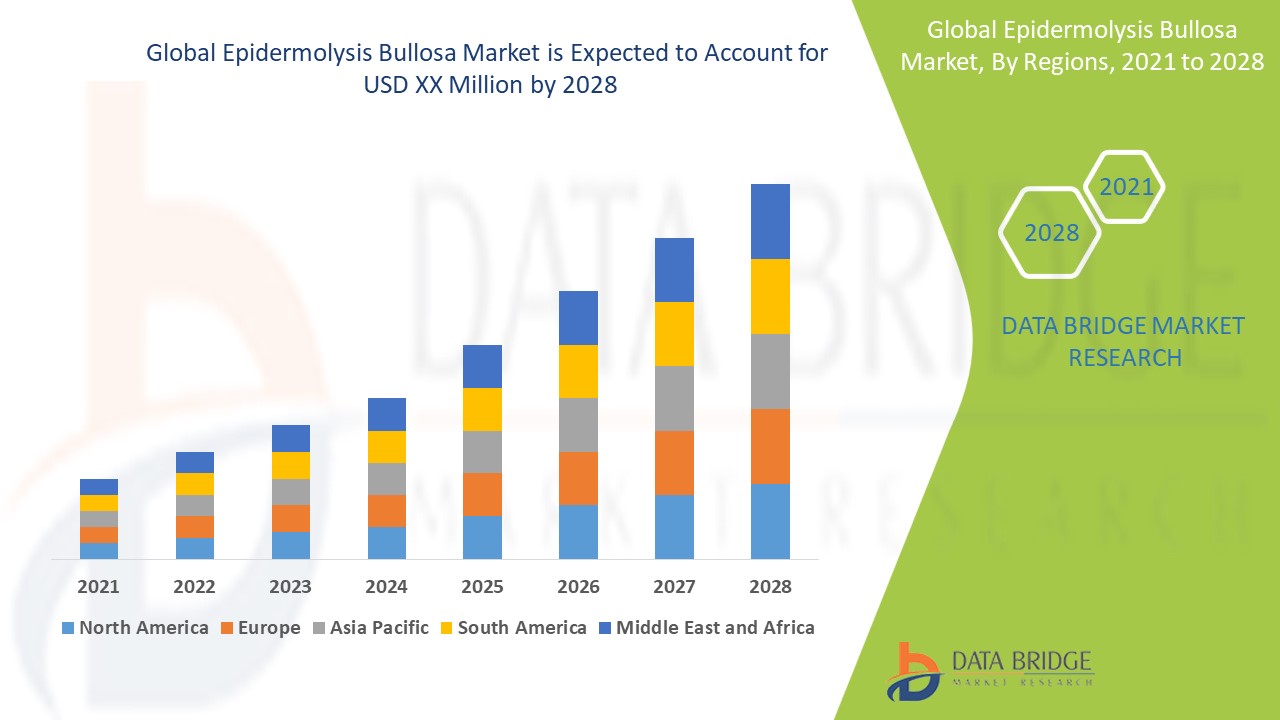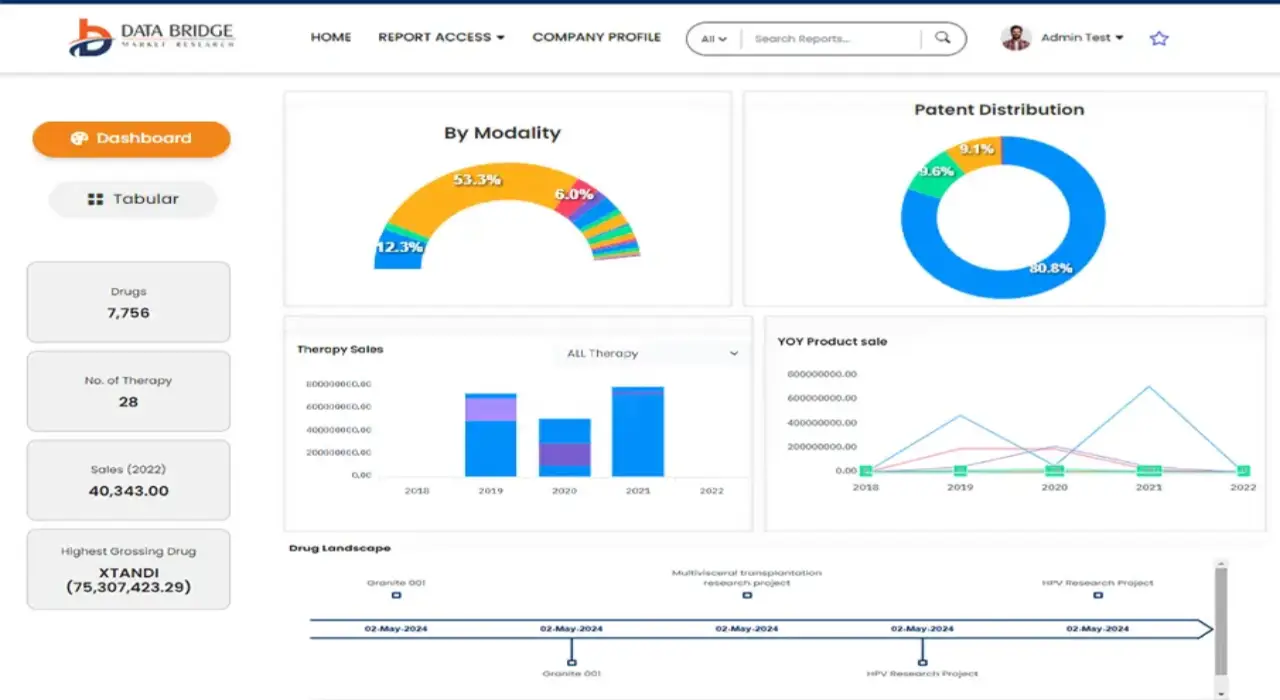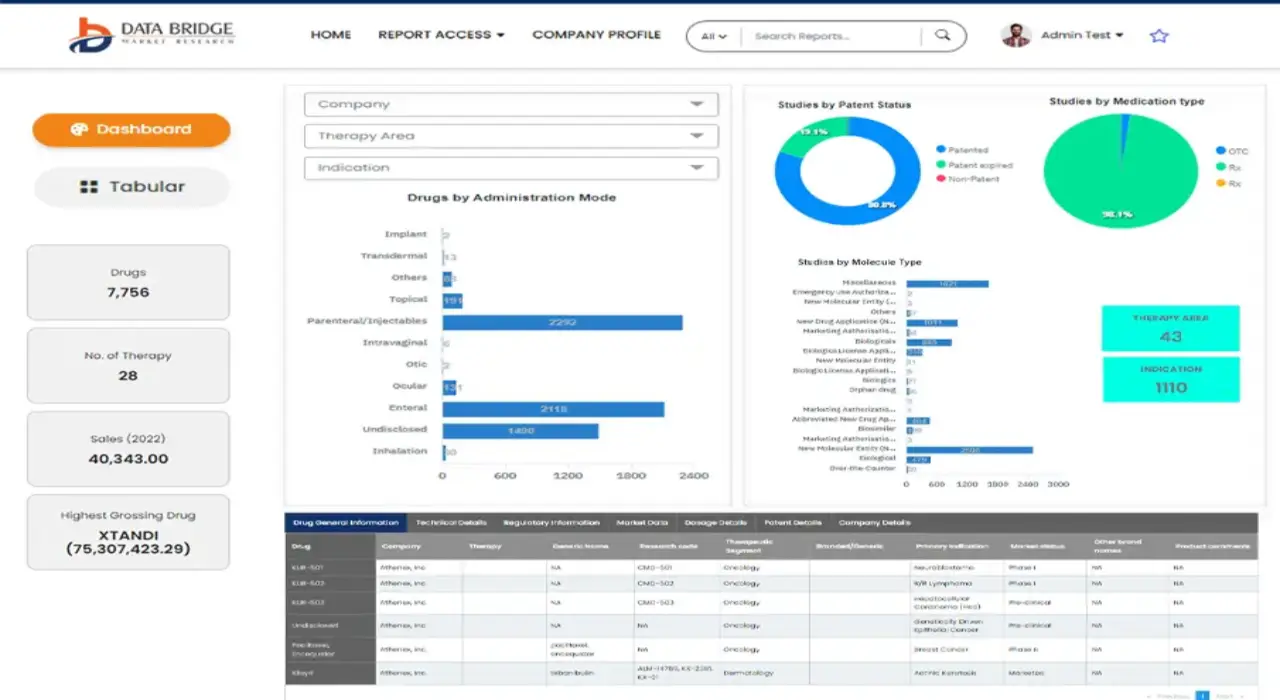Global Epidermolysis Bullosa Market
Market Size in USD Billion
CAGR :
% 
 USD
3.83 Billion
USD
5.78 Billion
2024
2032
USD
3.83 Billion
USD
5.78 Billion
2024
2032
| 2025 –2032 | |
| USD 3.83 Billion | |
| USD 5.78 Billion | |
|
|
|
|
Global Epidermolysis Bullosa Market Segmentation, By Drug (EB-101, Oleogel-S10, and Others), Drug Type (Antibiotics, Analgesics, and Other therapeutic), Mode of Administration (Injectables, Oral, and Others), Distribution Channel (Hospital Pharmacies, Retail Pharmacies, and Online Pharmacies), End User (Hospitals, Homecare, Specialty Clinics, and Others) – Industry Trends and Forecast to 2032
Epidermolysis Bullosa Market Analysis
The epidermolysis bullosa (EB) market has seen significant advancements in recent years, particularly in the development of gene therapy and targeted treatments. One of the latest methods includes the use of CRISPR-Cas9 gene editing technology, which is being explored for its potential to correct the genetic mutations that cause EB. This innovative approach could provide long-term solutions for treating the condition by repairing the underlying genetic defects at the DNA level.
Another major technological advancement is the use of biologic drugs, such as Amgen's Blautix, which has shown promise in improving skin integrity by enhancing collagen production. In addition, stem cell therapies are being actively researched to repair damaged skin tissue and promote wound healing in EB patients.
The growth of the EB market is driven by increasing awareness and a surge in research funding, leading to new treatment options and better care strategies. Pharmaceutical companies and research institutions are collaborating to develop more effective therapies, leading to a rise in clinical trials, which, in turn, is expected to fuel the market's expansion.
Epidermolysis Bullosa Market Size
The global epidermolysis bullosa market size was valued at USD 3.83 billion in 2024 and is projected to reach USD 5.78 billion by 2032, with a CAGR of 5.30% during the forecast period of 2025 to 2032. In addition to the insights on market scenarios such as market value, growth rate, segmentation, geographical coverage, and major players, the market reports curated by the Data Bridge Market Research also include depth expert analysis, patient epidemiology, pipeline analysis, pricing analysis, and regulatory framework.
Epidermolysis Bullosa Market Trends
“Increasing Focus on Gene Therapy for Epidermolysis Bullosa Treatment”
A significant trend driving growth in the epidermolysis bullosa (EB) market is the increasing focus on gene therapy as a treatment option. EB is a group of rare genetic disorders causing fragile skin and blistering, and researchers are exploring gene-editing techniques to correct the mutations causing the disease. For instance, companies such as Krystal Biotech are advancing gene therapy treatments, such as their ongoing clinical trials for Krystal-EB, a topical gene therapy for dystrophic EB. This approach targets the genetic root of the disease, offering potential for long-term solutions, rather than just symptom management. As gene therapy continues to show promising results, it is expected to propel market growth significantly.
Report Scope and Epidermolysis Bullosa Market Segmentation
|
Attributes |
Epidermolysis Bullosa Key Market Insights |
|
Segments Covered |
|
|
Countries Covered |
U.S., Canada and Mexico in North America, Germany, France, U.K., Netherlands, Switzerland, Belgium, Russia, Italy, Spain, Turkey, Rest of Europe in Europe, China, Japan, India, South Korea, Singapore, Malaysia, Australia, Thailand, Indonesia, Philippines, Rest of Asia-Pacific (APAC) in the Asia-Pacific (APAC), Saudi Arabia, U.A.E, South Africa, Egypt, Israel, Rest of Middle East and Africa (MEA) as a part of Middle East and Africa (MEA), Brazil, Argentina and Rest of South America as part of South America |
|
Key Market Players |
Biogen (U.S.), Pfizer Inc. (U.S.), F. Hoffmann-La Roche Ltd (Switzerland), Merck Sharp & Dohme Corp. (U.S.), Novartis AG (Switzerland), Sanofi (France), Teva Pharmaceutical Industries Ltd. (Israel), Orion Corporation (Finland), UCB S.A. (Belgium), Acadia Pharmaceuticals Inc. (U.S.), H. Lundbeck A/S (Denmark), and Mitsubishi Tanabe Pharma Corporation (Japan) |
|
Market Opportunities |
|
|
Value Added Data Infosets |
In addition to the insights on market scenarios such as market value, growth rate, segmentation, geographical coverage, and major players, the market reports curated by the Data Bridge Market Research also include depth expert analysis, patient epidemiology, pipeline analysis, pricing analysis, and regulatory framework. |
Epidermolysis Bullosa Market Definition
Epidermolysis bullosa (EB) is a rare genetic disorder that causes fragile skin and mucous membranes, making them highly susceptible to blistering and tearing with minimal friction or injury. It is caused by mutations in genes responsible for producing proteins that bind the layers of the skin together. There are several types of EB, ranging from mild to severe, with symptoms appearing at birth or in early childhood. Treatment focuses on wound care, pain management, and preventing infections, as there is currently no cure. In severe cases, complications can lead to scarring, deformities, or even life-threatening infections.
Epidermolysis Bullosa Market Dynamics
Drivers
- Rising Prevalence of Epidermolysis Bullosa
The rising prevalence of epidermolysis bullosa (EB) is a significant driver for the market. As healthcare access improves in developing regions, such as Africa and parts of Southeast Asia, the diagnosis and treatment of rare diseases such as EB are becoming more common. This increase in diagnosed cases has led to a higher demand for specialized treatments and care. For instance, in India, the establishment of EB support networks and access to advanced treatments has highlighted the need for effective therapies. As more people are diagnosed and treated, the demand for EB-specific treatments, including advanced wound care products and genetic therapies, is expected to grow, driving market expansion.
- Increasing Focus on Rare Disease Treatment
The increasing focus on rare diseases, including epidermolysis bullosa (EB), is a significant driver for market growth. Governments and pharmaceutical companies are dedicating more resources to developing treatments for orphan diseases, driven by incentives such as tax breaks and market exclusivity. As a result, EB is receiving more attention from researchers and drug developers, leading to innovative treatment solutions such as gene therapy, biologics, and advanced wound care products. The growing recognition of EB as a critical unmet medical need has fueled investment, partnerships, and clinical trials, expanding the range of treatment options available. This focus is accelerating the market's growth and improving patient outcomes.
Opportunities
- Advancements in Genetic Research
Recent progress in genetic research has significantly impacted the epidermolysis bullosa (EB) market, unlocking new opportunities. Advances in gene editing technologies, such as CRISPR, have enabled the development of targeted therapies that address the root causes of EB at a genetic level. Personalized treatments tailored to the genetic profile of individual patients are becoming more feasible, offering hope for more effective and long-term solutions. Furthermore, genetic research has accelerated the identification of potential biomarkers, enhancing diagnostic accuracy and treatment outcomes. This growing understanding of the genetic basis of EB is driving the development of innovative therapies, creating significant growth opportunities within the market.
- Patient Advocacy and Support Networks
Patient advocacy groups and support networks play a pivotal role in creating opportunities within the epidermolysis bullosa (EB) market. These organizations raise awareness about the condition, ensuring that more individuals receive early diagnoses and appropriate care. They also facilitate fundraising initiatives and secure financial support for research and development of innovative treatments. By collaborating with pharmaceutical companies and research institutions, these groups help accelerate the development of therapies, including gene therapies and wound care solutions. Furthermore, they advocate for policy changes and increased government funding, fostering a favorable environment for EB treatments, ultimately driving growth and expansion in the market.
Restraints/Challenges
- High Treatment Costs
High treatment costs are a significant restraint for the epidermolysis bullosa (EB) market. Developing and administering therapies, such as gene treatments and skin replacement techniques, involves substantial expenses, including research, development, and specialized care. These costs make access to treatments limited, especially in low-income regions or for uninsured patients, thereby hindering overall market growth. The financial burden of these therapies may prevent widespread adoption, creating disparities in treatment availability. As a result, despite advancements in EB treatments, the high price point remains a key barrier, restricting the market's expansion and limiting the potential to address the growing demand for effective EB therapies globally.
- Complexity of Treatment
The complexity of treating epidermolysis bullosa (EB) poses a significant challenge to the market. EB consists of several subtypes, each with its own unique symptoms, severity, and progression. This diversity makes it difficult to create a universal treatment approach. Therapies must be tailored to address the specific needs of each subtype, which complicates the development of effective, standardized treatments. The need for personalized care increases the complexity of managing EB, making it challenging for healthcare providers to ensure consistent outcomes. In addition, the lack of one-size-fits-all solutions delays the adoption of new treatments and limits market expansion, as the development of targeted therapies becomes more intricate and resource-intensive.
This market report provides details of new recent developments, trade regulations, import-export analysis, production analysis, value chain optimization, market share, impact of domestic and localized market players, analyses opportunities in terms of emerging revenue pockets, changes in market regulations, strategic market growth analysis, market size, category market growths, application niches and dominance, product approvals, product launches, geographic expansions, technological innovations in the market. To gain more info on the market contact Data Bridge Market Research for an Analyst Brief, our team will help you take an informed market decision to achieve market growth.
Epidermolysis Bullosa Market Scope
The market is segmented on the basis of drug, drug type, mode of administration, distribution channel, and end user. The growth amongst these segments will help you analyze meagre growth segments in the industries and provide the users with a valuable market overview and market insights to help them make strategic decisions for identifying core market applications.
Drug
- EB-101
- Oleogel-S10
- Others
Drug Type
- Antibiotics
- Analgesics
- Other therapeutic
Mode of Administration
- Injectables
- Oral
- Others
Distribution Channel
- Hospital Pharmacies
- Retail Pharmacies
- Online Pharmacies
End User
- Hospitals
- Homecare
- Specialty Clinics
- Others
Epidermolysis Bullosa Market Regional Analysis
The market is analysed and market size insights and trends are provided by country, drug, drug type, mode of administration, distribution channel, and end user as referenced above.
The countries covered in the market report are U.S., Canada, Mexico in North America, Germany, Sweden, Poland, Denmark, Italy, U.K., France, Spain, Netherland, Belgium, Switzerland, Turkey, Russia, Rest of Europe in Europe, Japan, China, India, South Korea, New Zealand, Vietnam, Australia, Singapore, Malaysia, Thailand, Indonesia, Philippines, Rest of Asia-Pacific (APAC) in Asia-Pacific (APAC), Brazil, Argentina, Rest of South America as a part of South America, U.A.E, Saudi Arabia, Oman, Qatar, Kuwait, South Africa, Rest of Middle East and Africa (MEA) as a part of Middle East and Africa (MEA)
North America is expected to dominate the epidermolysis bullosa market due to the effective inorganic growth strategies adopted by key market players in the region. These strategies include partnerships, acquisitions, and collaborations, which enhance research and development efforts. In addition, the presence of advanced healthcare infrastructure, high healthcare expenditure, and a strong focus on innovative treatment options further boost market growth in North America, making it a leader in the global epidermolysis bullosa market.
The country section of the report also provides individual market impacting factors and changes in regulation in the market domestically that impacts the current and future trends of the market. Data points such as down-stream and upstream value chain analysis, technical trends and porter's five forces analysis, case studies are some of the pointers used to forecast the market scenario for individual countries. Also, the presence and availability of global brands and their challenges faced due to large or scarce competition from local and domestic brands, impact of domestic tariffs and trade routes are considered while providing forecast analysis of the country data.
Epidermolysis Bullosa Market Share
The market competitive landscape provides details by competitor. Details included are company overview, company financials, revenue generated, market potential, investment in research and development, new market initiatives, global presence, production sites and facilities, production capacities, company strengths and weaknesses, product launch, product width and breadth, application dominance. The above data points provided are only related to the companies' focus related to market.
Epidermolysis Bullosa Market Leaders Operating in the Market Are:
- Biogen (U.S.)
- Pfizer Inc. (U.S.)
- F. Hoffmann-La Roche Ltd (Switzerland)
- Merck Sharp & Dohme Corp. (U.S.)
- Novartis AG (Switzerland)
- Sanofi (France)
- Teva Pharmaceutical Industries Ltd. (Israel)
- Orion Corporation (Finland)
- UCB S.A. (Belgium)
- Acadia Pharmaceuticals Inc. (U.S.)
- H. Lundbeck A/S (Denmark)
- Mitsubishi Tanabe Pharma Corporation (Japan)
Latest Developments in Epidermolysis Bullosa Market
- In November 2024, Abeona Therapeutics Inc. announced the FDA’s acceptance of the resubmission of its Biologics License Application (BLA) for prademagene zamikeracel (pz-cel), a novel autologous cell-based gene therapy. This investigational therapy aims to treat recessive dystrophic epidermolysis bullosa. The FDA set April 29, 2025, as the target date for a decision under the Prescription Drug User Fee Act (PDUFA)
- In May 2023, Krystal Biotech, Inc. revealed that the U.S. FDA had approved VYJUVEK (beremagene geperpavec-svdt) for treating dystrophic epidermolysis bullosa in individuals aged six months and older. VYJUVEK targets the genetic cause of the disease by delivering functional copies of the COL7A1 gene, promoting wound healing, and enabling long-term COL7 protein expression with redosing
SKU-
Get online access to the report on the World's First Market Intelligence Cloud
- Interactive Data Analysis Dashboard
- Company Analysis Dashboard for high growth potential opportunities
- Research Analyst Access for customization & queries
- Competitor Analysis with Interactive dashboard
- Latest News, Updates & Trend analysis
- Harness the Power of Benchmark Analysis for Comprehensive Competitor Tracking
Research Methodology
Data collection and base year analysis are done using data collection modules with large sample sizes. The stage includes obtaining market information or related data through various sources and strategies. It includes examining and planning all the data acquired from the past in advance. It likewise envelops the examination of information inconsistencies seen across different information sources. The market data is analysed and estimated using market statistical and coherent models. Also, market share analysis and key trend analysis are the major success factors in the market report. To know more, please request an analyst call or drop down your inquiry.
The key research methodology used by DBMR research team is data triangulation which involves data mining, analysis of the impact of data variables on the market and primary (industry expert) validation. Data models include Vendor Positioning Grid, Market Time Line Analysis, Market Overview and Guide, Company Positioning Grid, Patent Analysis, Pricing Analysis, Company Market Share Analysis, Standards of Measurement, Global versus Regional and Vendor Share Analysis. To know more about the research methodology, drop in an inquiry to speak to our industry experts.
Customization Available
Data Bridge Market Research is a leader in advanced formative research. We take pride in servicing our existing and new customers with data and analysis that match and suits their goal. The report can be customized to include price trend analysis of target brands understanding the market for additional countries (ask for the list of countries), clinical trial results data, literature review, refurbished market and product base analysis. Market analysis of target competitors can be analyzed from technology-based analysis to market portfolio strategies. We can add as many competitors that you require data about in the format and data style you are looking for. Our team of analysts can also provide you data in crude raw excel files pivot tables (Fact book) or can assist you in creating presentations from the data sets available in the report.













